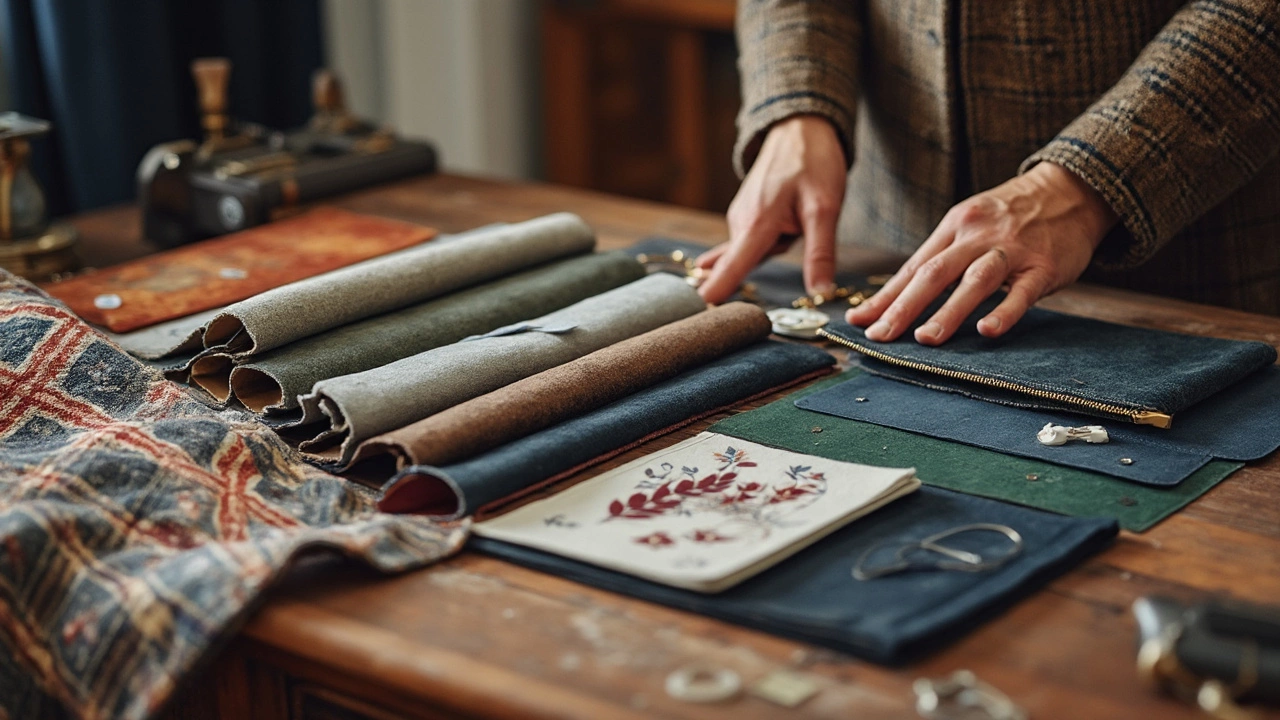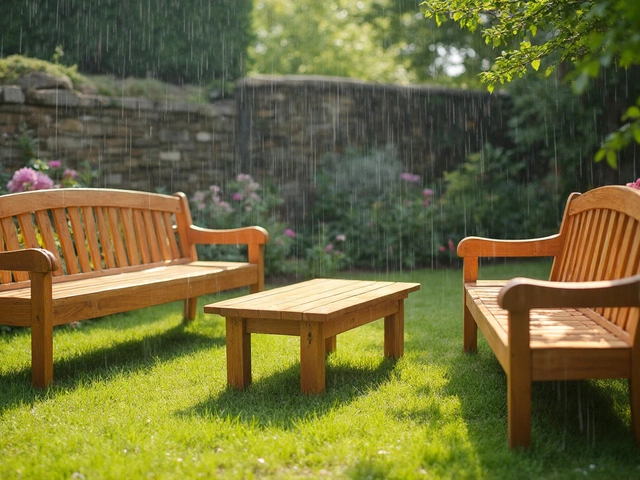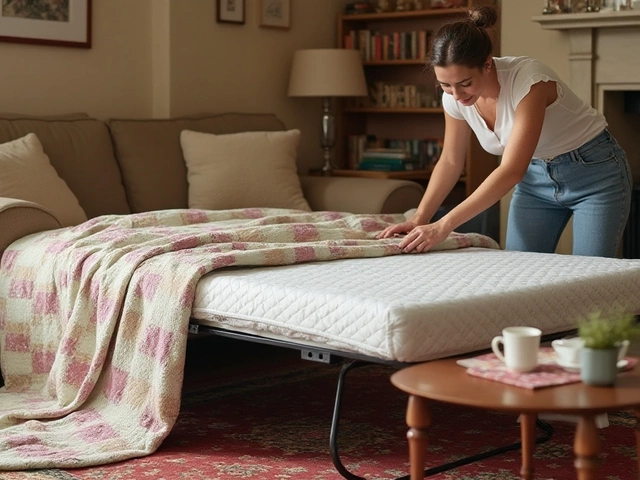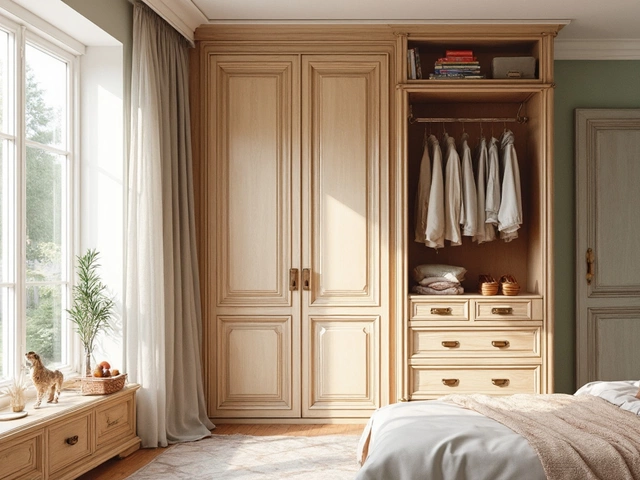Ever walk into a fancy furniture store, spot a gorgeous sofa, check the price tag, and feel your jaw drop? Sofas can cost as much as a used car. So, do they actually deserve that price, or are you just paying for a fancy brand name?
Let’s skip the sales talk and get into what you really need to know. First, expensive sofas don’t just look good. Most of the time, you’re paying for sturdy frames, higher-quality foam, and real materials—things that actually last. Ever sat on a cheap sofa and heard it creak or felt a spring poke your back after a year? That won’t happen with a well-built, pricier one.
But here’s the catch—not all expensive sofas are created equal. Some brands charge more just for the name, while others actually use better wood, denser cushions, and tougher fabrics. There’s no secret sauce, but there is a big difference between paying for quality and paying for hype.
- What Makes a Sofa Expensive?
- Quality vs. Looks—Does Price Matter?
- Comfort and Longevity: What You Don’t See
- The Real-Life Costs Beyond the Price Tag
- When to Splurge, When to Save
- Tips for Getting the Most Value
What Makes a Sofa Expensive?
If you’ve ever checked out the price tags at both big box and high-end furniture stores, you might wonder why one sofa costs five times more than another. It usually boils down to three things: what it’s made from, how it’s put together, and who's behind the brand.
The frame is a big deal. The most durable and long-lasting sofas almost always use kiln-dried hardwood frames. These frames don’t warp or crack like plywood or cheap softwoods. If you see words like “solid oak,” “beech,” or “kiln-dried hardwood,” that’s money well spent. A lot of cheaper sofas use particle board or stapled plywood, which just doesn’t hold up as well.
Then you’ve got suspension—the part under the cushion. The gold standard here is eight-way hand-tied springs. Skilled workers actually tie each spring eight ways, which takes a lot of time and makes for killer comfort. Less expensive sofas use simple webbing, S-shaped (or zig-zag) springs, or even flat boards. They save money, but you can actually feel the difference.
Cushions matter too. High-end sofas use dense foam (typically rated above 2.0 lbs/cubic foot) or even natural latex. Feather or down wrapped cushions crank up the price as well. Budget sofas usually grab low-density foam, which just doesn’t bounce back after a year or two.
- expensive sofas mostly use real leather, top-notch performance fabrics, or even wool blends, while cheap versions go for bonded leather or basic polyester.
- Workmanship shows up in details: double-stitching instead of glue, careful pattern matching on the fabric, and hand upholstery.
- The brand itself hikes the price sometimes, but top makers stand behind their sofas with 10+ year warranties or free repairs. That’s not something you’ll see from the budget brands.
Here’s a quick look at what you typically get as you go up in price:
| Feature | Cheap Sofa | Expensive Sofa |
|---|---|---|
| Frame Material | Plywood/Particle Board | Kiln-Dried Hardwood |
| Suspension | Zig-Zag Springs/Webbing | 8-Way Hand-Tied Springs |
| Cushion Fill | Low-Density Foam | High-Density Foam/Down/Memory Foam |
| Fabric/Leather | Polyester/Bonded Leather | Full-Grain Leather/Wool/Performance Fabric |
| Warranty | 1-3 Years (sometimes none) | 10-25 Years |
The short version? Expensive sofas cost more because makers spend more on materials, labor, and guarantees. Sometimes it’s hype, but a lot of it is real, built-in value that helps your sofa last a decade or longer.
Quality vs. Looks—Does Price Matter?
Let’s get real—some sofas are eye candy but barely hold up to everyday life. Others look plain but outlast trends and roughhousing kids. Price doesn’t always nail down which is which, but there are some honest signals to watch.
Most expensive sofas use hardwood frames like kiln-dried oak or beech. These woods don’t warp with time and humidity, unlike the plywood or particleboard you find in budget options. According to Consumer Reports, sofas with hardwood frames usually last between 7 and 15 years, compared to just 2 to 5 years for particleboard or plastic frames.
The fabric matters a ton, too. Higher-end sofas usually use tough stuff like top-grain leather or heavy cotton weave that can laugh off spilled coffee and pets’ claws. Cheaper sofas often use thin synthetics that rip or pill within months. The inside cushion counts as well: high-density foam means you won’t sink in like you’re on a deflated air mattress after a year.
Looks do play into pricing. Some brands hike up costs just for trending designs or showing off a logo. But looks fade, and unless quality backs up the style, you’re paying extra for something you’ll regret later. If you’re not sure what goes into the price, check the details—not just the color.
Here’s a quick comparison so you don’t just take my word for it:
| Feature | Expensive Sofa | Cheap Sofa |
|---|---|---|
| Frame Material | Kiln-dried hardwood | Plywood, particleboard |
| Average Lifespan | 7–15 years | 2–5 years |
| Fabric Type | Heavy cotton, leather, performance fabric | Polyester, thin blends |
| Foam Density | High (1.8-2.5 lbs/ft³) | Low (<1.5 lbs/ft³) |
| Repairability | Usually possible | Rarely worth it |
Bottom line: A high price tag doesn’t promise quality, but true quality usually demands a higher price. Even if you’re drawn in by a cool design, dig deeper into what’s under the hood. That’s where your money should go.
Comfort and Longevity: What You Don’t See
Let’s get real—most people judge a sofa by how it looks or feels in a showroom, but that’s just the start. Underneath the covers, there’s a big gap between a bargain sofa that sags after a year and a well-built one that still hugs you after a decade.
The comfort of a sofa comes from several parts you usually never see. Expensive options usually have a sturdy hardwood frame (like kiln-dried oak or beech, not soft pine or particleboard), high-density foam, strong joints, and proper suspension. Cheap sofas? They often skip these steps. Next thing you know, you’re fighting with sunken cushions and wobbly arms way sooner than you’d hoped.
Why does this matter? A higher foam density (about 1.8 to 2.5 pounds per cubic foot) keeps cushions from going flat. Good springs, like eight-way hand-tied ones, spread weight so you’re not sinking in odd spots. Upholstery matters too—real leather and tough fabrics outlast synthetics by years.
Check out the differences below:
| Feature | Expensive Sofas | Cheap Sofas |
|---|---|---|
| Frame Material | Solid hardwood (kiln-dried) | Pine, plywood, or particleboard |
| Cushion Foam Density | 1.8 – 2.5 lbs/cu ft | Less than 1.5 lbs/cu ft |
| Suspension | Eight-way hand-tied springs | Simple webbing or coils |
| Fabric/Upholstery | Premium leather, tightly woven fabric | Synthetic blends, thin fabric |
| Typical Lifespan | 10-15 years | 2-5 years |
Here’s something you might not hear from a furniture salesperson: spending more can also mean better back and hip support. Studies from furniture testing labs have shown that higher-end sofas keep their shape and firmness, which pays off if you sit for hours, work from home, or just want to nap without waking up sore.
Quick tip—try out sofas in-store and ask about the stuff inside, not just the cover. Look for brands willing to share the details. That’s how you’ll know if your expensive sofa is built for years, not just Instagram photos.

The Real-Life Costs Beyond the Price Tag
Think a sofa’s price tag tells the whole story? Not even close. The sticker shock is just part of it. When you fork out cash for an expensive sofa, you’re also investing in things you won’t see on day one—but you will definitely notice over time.
First, let’s talk about maintenance. Cheaper sofas often stain, sag, or wear out way faster. If you’ve ever tried to clean a bargain couch only to end up with a weird stain that never leaves, you know the pain. Better-quality fabrics are more stain-resistant, and some even have built-in tech to repel spills—saving you on professional cleanings down the road. For families or pet owners, that adds up fast.
Repairs stack up, too. A low-cost sofa might need a new cushion core, leg replacements, or even reupholstering after just a few years. Brands selling pricey sofas often offer longer warranties—sometimes up to 15 years—so if anything does go wrong, you’re not forking out more cash.
Then there’s delivery, setup, and sometimes removal of your old sofa. Expensive sofas often come with free white-glove delivery services. That means your sofa gets toted up stairs, put together right in your living room, and all the packaging is whisked away (no awkward wrestling with cardboard). Cheap sofas? You usually end up juggling heavy boxes and an Allen wrench just to get the thing inside. Here’s a snapshot of what you can expect depending on the sofa’s price bracket:
| Type | Average Delivery & Setup Cost | Warranty Period | Estimated Lifespan |
|---|---|---|---|
| Budget Sofa | $75 (self-setup often required) | 1-2 years | 3-5 years |
| Mid-range/Specialty Sofa | $150-$250 (professional setup, sometimes included) | 5-10 years | 7-12 years |
| Expensive Sofas | Usually included (white-glove delivery) | 10-15 years | 15+ years |
Something people forget: resale value. Yep, some high-end couches actually hold value on secondhand markets if they’re well-cared for. A cheap one? Pretty much worthless once used.
- Maintenance costs drop with better materials.
- Longer warranties = less worry about surprise repairs.
- Professional delivery saves you time, risk, and hassle.
- Expensive sofas can sometimes be re-sold for a decent price.
So, before you write off a pricey sofa, remember: you’re not just buying a seat, you’re buying years of easier living—and a lot less stress about stains or sagging springs down the line.
When to Splurge, When to Save
If you’ve ever wondered if that high price tag is really worth it, you’re not alone. Spending big money on a sofa makes sense in some cases, but not all. You want the best for your space, without tossing cash down the drain. Here’s how to tell when to splurge and when to go budget.
Expensive sofas are usually a smart buy if durability is your top priority. If you have kids, pets, or just a lot of people crashing on your couch, you need frames made from kiln-dried hardwood, not particle board. Beat-up cheap sofas can sag and break fast, but better woods hold up for more than a decade. Brands like Joybird and West Elm often use quality wood and construction in their higher-end models, which matters if you want the sofa to last through a few moves or roughhousing teenagers.
Next, splurge when you care about comfort and back support. Not all cushions are created equal. High-resilience foam keeps its shape much longer than cheaper foams, avoiding that lumpy feeling. Down-blend cushions add plush comfort, but they often cost extra. If you need a comfy spot that’s cozy year after year, the pricier options usually pay off.
Aesthetics count too. If your sofa is the centerpiece of your living room and you know you’ll keep it for a long time, go ahead and invest in a timeless style, good stitching, and stain-resistant fabric. Polyester and microfiber blends on mid-range sofas aren’t as durable or easy to clean as performance fabrics or well-treated leather. Real leather, especially full-grain or top-grain, lasts the longest if cared for properly.
But here’s when to save your cash: If you’re renting, planning to move soon, or are the type who switches up your style every few years, it makes sense to spend less. Fast furniture from IKEA or local stores get the job done for short-term living, college years, or your first apartment. Also, save money on a “just for show” piece like a sofa in a formal living room that rarely gets used.
- Splurge if the sofa will see daily use or if you plan to keep it a decade or more.
- Save if you’re only keeping it for a couple of years or it’s just for looks.
- Check frame material—hardwood is splurge-worthy, fiberboard and softwood are not.
- Padding and cushion quality make a big difference; high-resilience foams last longer.
- Don’t pay extra for fancy brand names if the materials aren’t better than mid-priced options.
End of the day, focus on getting value. Sometimes, spending more upfront really does mean saving on hassle and replacement later. But if your needs are basic, skip the hype and put your money where it actually matters—to you.
Tips for Getting the Most Value
Getting your money’s worth with a sofa doesn’t mean just chasing the highest price or the fanciest design. Here’s how you can stretch your dollar and still wind up with a sofa that is comfortable, sturdy, and stylish.
- Expensive sofas often last longer, but make sure you’re paying for real quality. For frames, look for kiln-dried hardwood (like oak, maple, or ash). These woods don’t warp or crack like softer or composite woods do.
- Check the warranty. Good brands back their materials and workmanship for at least 5–10 years. If the warranty's vague or short, that's a red flag.
- Test before you buy. When shopping in-store, don’t be shy—plop down, wiggle, and check those joints for creaks. Cheap sofas feel wobbly even when new.
- If buying online, zoom in on close-up photos, check assembly details, and read real buyer reviews about comfort and wear after a few years.
- Don’t pay just for brand hype. Some lesser-known brands beat the big names on durability, so compare construction details and materials.
- Look for removable, washable covers if you’ve got kids or pets. Upholstery that’s easy to clean can double your sofa’s look and lifespan.
Here’s a quick breakdown showing what you really get by spending more, on average:
| Feature | Cheap Sofas (<$1500) | Mid-Range ($1500–$3500) | Premium (>$3500) |
|---|---|---|---|
| Frame Material | Plywood/Softwood | Mixed/Kiln-dried Hardwood | All Kiln-dried Hardwood |
| Warranty | 6–24 months | 2–7 years | 10+ years |
| Average Lifespan | 3–6 years | 7–12 years | 15+ years |
| Cushion Quality | Basic foam (quickly sags) | High-density/foam-core | Memory foam, feather, latex options |
| Maintenance | Spot clean, rarely removable covers | Some washable covers | Often full removable/washable covers |
You’ll get the most value by matching what you really need to your budget. A family with kids and pets usually gets more value from a mid-range sofa with strong fabrics than from a jaw-dropping designer piece. If you move a lot, lighter frames (and lower prices) might make more sense than a sofa built to last 20 years. The point: buy for your life, not someone else’s Instagram.





